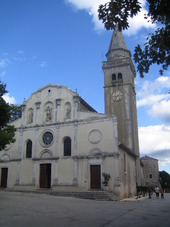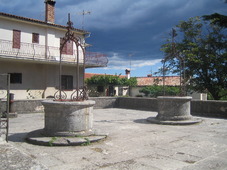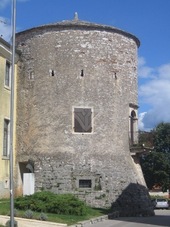to enlarge


or choose the place
from the menu below
 Rome |
 Byzantium |
 Venice |
 Vienna |
 Brioni |
 Smrikve |
 |
 |
 From here you can take the street that goes towards the centre of the town and the spacious
town square where the Parish Church of St. Michael the Archangel is located.
From here you can take the street that goes towards the centre of the town and the spacious
town square where the Parish Church of St. Michael the Archangel is located.
The Parish Church was built on the place of an older church from the 11th – 12th century but its current Baroque façade was completed between 1625 and 1718.
There are three sculptures on the façade and the one in the middle represents the St. Michael. The bell tower is very nice and has the Venetian form. Its interior houses a rich Baroque inventory, especially valuable pulpits and altars.
On the street towards the Parish Church you will note several old buildings. If you look carefully the second street on your left side you will note the small Church of St. Anthony the Abbot from 1381. This church houses a series of high quality but damaged frescoes made by a Venetian Master, named Amerigus.
The frescoes were made at the end of the 14th century, depicting the crowning of Our Lady, the life of St. Anthony and other scenes from the Christ’s life. In that area there is also an interesting private well.
Few meters from there you will be in front of the Parish Church. Many centuries ago in this place was located the old castle. If you look on the left side of the Parish Church you will note another church. This small stone made Church of the Holy Trinity dates back into the 14th century and houses fresco paintings from 1471 depicting scenes of Christ’s life.
 The Master who painted the 31 different scene probably belonged to Slovene or a German workshops
and locally was known as Master from Zminj. The pictures have suffered significant damages over time.
The Master who painted the 31 different scene probably belonged to Slovene or a German workshops
and locally was known as Master from Zminj. The pictures have suffered significant damages over time.
The church was built in 1311 and restructured in 1651 but it still preserve a very nice stone roof.
On the opposite side of the church, you will note a public well with two wells like the one in Vizinada and Marcana.
 On this site of the street, attached to
the building nearby the Parish Church and the Chakavian house, there is the round defence tower
of the castle that dates back into the 15th century.
On this site of the street, attached to
the building nearby the Parish Church and the Chakavian house, there is the round defence tower
of the castle that dates back into the 15th century.
In this place we are on the top of the hill; 391 meters above sea level.
If you continue to follow the street that goes nearby the round defence tower and goes downside the hill you will arrive in the street that become the main street during Bartulja day. During the Bartulja day the crowd of people create a human river from morning till late in the night.
Few hundred meters after this main “Bartulja street” that goes towards Pican, at the end of Zminj, in a small and clean wood, you will see the place where animals fair take place every year.
There are two other interesting houses to be seen in Zminj and they are particular for the stone sculptures and inscriptions they have on their façades.
To find them you will have to ask the indications from someone from the place.
Those houses are located on the road that goes towards the cemetery Church of St. Cross in the southern part of Zminj.
The Church of St. Cross was built in the 15th century and has the typical Istrian architecture for the small churches with the porch.
The best way to arrive near to the area where those stone sculptures are, is to take the street that goes from the Parish Church towards the place where you left your car and to take the first street that goes on the left. About 20 meters from there you will be in the area where the sculptures are.